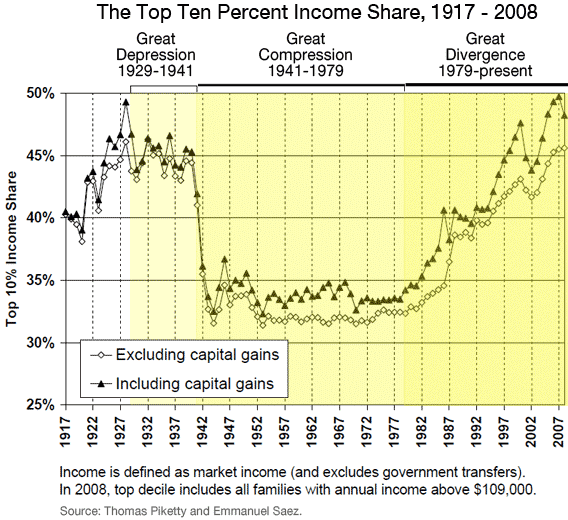The United States of InequalityIntroducing the Great Divergence
By Timothy Noah
Posted Friday, Sept. 3, 2010, at 3:06 PM ET
<snip>
In 1915, a statistician at the University of Wisconsin named Willford I. King published The Wealth and Income of the People of the United States, the most comprehensive study of its kind to date. The United States was displacing Great Britain as the world's wealthiest nation, but detailed information about its economy was not yet readily available; the federal government wouldn't start collecting such data in any systematic way until the 1930s. One of King's purposes was to reassure the public that all Americans were sharing in the country's newfound wealth.
King was somewhat troubled to find that the richest 1 percent possessed about 15 percent of the nation's income. (A more authoritative subsequent calculation puts the figure slightly higher, at about 18 percent.)
This was the era in which the accumulated wealth of America's richest families�the Rockefellers, the Vanderbilts, the Carnegies�helped prompt creation of the modern income tax, lest disparities in wealth turn the United States into a European-style aristocracy. The socialist movement was at its historic peak, a wave of anarchist bombings was terrorizing the nation's industrialists, and President Woodrow Wilson's attorney general, Alexander Palmer, would soon stage brutal raids on radicals of every stripe. In American history, there has never been a time when class warfare seemed more imminent.
That was when the richest 1 percent accounted for 18 percent of the nation's income. Today, the richest 1 percent account for 24 percent of the nation's income. What caused this to happen? Over the next two weeks, I'll try to answer that question by looking at all potential explanations�race, gender, the computer revolution, immigration, trade, government policies, the decline of labor, compensation policies on Wall Street and in executive suites, and education. Then I'll explain why people who say we don't need to worry about income inequality (there aren't many of them) are wrong.
Income inequality in the United States has not worsened steadily since 1915. It dropped a bit in the late teens, then started climbing again in the 1920s, reaching its peak just before the 1929 crash. The trend then reversed itself. Incomes started to become more equal in the 1930s and then became dramatically more equal in the 1940s. Income distribution remained roughly stable through the postwar economic boom of the 1950s and 1960s. Economic historians Claudia Goldin and Robert Margo have termed this midcentury era the "Great Compression." The deep nostalgia for that period felt by the World War II generation�the era of Life magazine and the bowling league�reflects something more than mere sentimentality. Assuming you were white, not of draft age, and Christian, there probably was no better time to belong to America's middle class.

The Great Compression ended in the 1970s. Wages stagnated, inflation raged, and by the decade's end, income inequality had started to rise. Income inequality grew through the 1980s, slackened briefly at the end of the 1990s, and then resumed with a vengeance in the aughts. In his 2007 book The Conscience of a Liberal, the Nobel laureate, Princeton economist and New York Times columnist Paul Krugman labeled the post-1979 epoch the "Great Divergence."
<snip>
Much More:
http://www.slate.com/id/2266025/entry/2266026/?from=rss:kick: